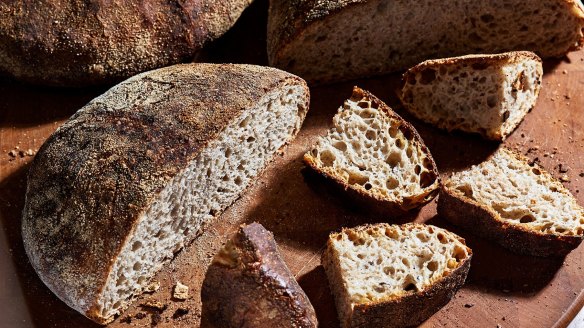How to make no-knead bread in a Dutch oven

One of my favourite Julia Child anecdotes involves her epic quest to achieve a perfectly baked French baguette in a home oven for the second volume of the seminal cookbook Mastering the Art of French Cooking. It took a year (yes, a year!) to accomplish, but in her trademark doggedness, she, with assistance from her husband and others, did it.
An important part of achieving an authentic bread: The crust. And key to that was figuring out how to replicate the heat and steam of a professional oven. The answer, as recalled in Bob Spitz's 2012 biography of the trailblazing cookbook author and television host, lay in lining the oven with quarry tiles and dropping a hot brick in a pan of water.
Thankfully, we don't have to go to the lengths Child did to get a good crusty bread.
Instead, the answer lies in a common piece of kitchen equipment you may already have: A pot, ideally a Dutch oven. Yes, if your prestige piece of enamelled cast-iron isn't getting as much use as you think it should, now is the time to pull it out. Get ready for some of the crustiest bread you've ever had.
For this recipe, I have turned to Jim Lahey, the baker and cookbook author who helped turn no-knead bread into a mainstream concept.
My first loaf: Superb. My second, third, fourth and fifth loaves: Just as wonderful. One of the star attractions was the crusty crust. The oven within the oven makes all the difference. You preheat the Dutch oven for about half an hour before baking, so it's screaming hot by the time you gently dump the dough in. It's so hot you can actually hear the dough start cooking when it hits the surface of the pot.
One of the star attractions was the crusty crust.
Wonderfully crackling, if a bit messy when slicing, this crust encases a delightfully chewy interior made especially airy by the high proportion of water in the dough. (Refresher: No-knead doughs work because the wetter dough means the gluten, or protein, strands can slip around to find each other and form that trademark structure.)
Note: The dough needs to rest and rise twice; first for 12 to 18 hours, and after it's shaped, for 1 to 2 hours (all at room temperature).
No-knead whole wheat bread recipe
INGREDIENTS
300 grams (2¼ cups) bread flour, plus more for the work surface
100 grams (¾ cup) whole-wheat flour
1¼ teaspoons salt
½ teaspoon dried instant yeast
300 grams (1⅓ cups) cool water (12 to 18C)
Wheat bran or cornmeal, for dusting (may use additional flour)
METHOD
Step 1: Stir together the flours, salt and yeast in a medium bowl. Add the water; use a wooden spoon or your hands to mix until you have a wet, sticky dough, about 30 seconds. Cover the bowl and let the mixture sit at room temperature until its surface is dotted with bubbles and the dough has more than doubled in size, 12 to 18 hours.
Step 2: Generously dust a work surface with flour. Use a rubber spatula or lightly floured hands to scrape the dough onto the surface in one piece. Use your lightly floured hands to lift the edges of the dough up and in toward the centre. Gently pinch the pulled-up dough together, cupping the edges in your hands as needed to nudge it into a round (don't worry about making it a perfect circle).
Step 3: Place a clean dish towel on your work surface; generously dust the towel with wheat bran, cornmeal or flour. Gently place the dough on the towel, seam side down. If the dough feels sticky, dust the top lightly with more wheat bran, cornmeal or flour. Fold the ends of the towel loosely over the dough to cover it. Place the dough in a warm, draft-free spot to rise for 1 to 2 hours. The dough is ready when it has almost doubled in size. When you gently poke the dough with your finger, it should hold the impression. If it springs back, let it rise for an additional 15 minutes.
Step 4: About half an hour before you think the second rise is complete, position a rack in the lower third of the oven and place a 4- to 5-litre heavy Dutch oven or pot with a lid in the centre of the rack. Preheat to 240C.
Step 5: Use pot holders to carefully remove the preheated pot from the oven, then lift off the lid. Uncover the dough. Quickly but gently invert it off the towel and into the pot, seam side up. (Use caution - the pot and lid will be very hot.) Cover with the lid; bake (lower rack) for 30 minutes.
Step 6: Remove the lid; continue baking until the loaf is a deep chestnut colour but not burned, 15 to 30 minutes more. (If you like a more precise measure, the bread is done when an instant-read thermometer inserted into the centre of the bread registers 90-100C. ) Use a heatproof spatula or pot holders to carefully lift the bread out of the pot and place it on a rack to cool thoroughly before serving or storing.
Recipe adapted from My Bread: The Revolutionary No-Work, No-Knead Method, by Jim Lahey (W. W. Norton, 2009).
The Washington Post